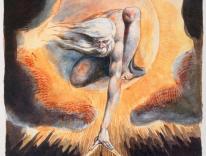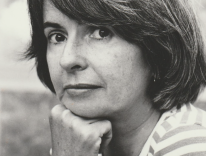
In 2009, C. E. Morgan published All the Living, a lonesome, lovely debut novel set on a Kentucky tobacco farm. Morgan knew the landscape well: she grew up just over the border in southern Ohio and attended Berea College, a tuition-free liberal arts college in Madison County, Kentucky.
Morgan wrote the first draft of All the Living in a mere fourteen days, the period between semesters at Harvard Divinity School, where she was studying religion and literature at the time. Despite its sudden birth, the book has a chiseled feel. The prose has clarity and heft, strengths derived from Morgan’s Biblical cadences and from her sensitivity to the Kentucky landscape. There are remarkable sentences on almost every page: “The white bunched blossoms had breasted out of their buds overnight”; a trailer “jagged out like an aluminum finger from a limestone wall topped by firs, bone out of bone”; “it was as though someone had come along with a plane and sheared off all the extra that once cushioned him. He was like something corded, every movement curtailed.” Recognition immediately followed publication. Morgan won a Whiting Award and a Lannan Literary Fellowship. In 2010, she was selected as a “5 Under 35” by the National Book Foundation. In February, she received one of Yale University’s three Windham-Campbell Prizes in Fiction, and with it a $150,000 award.
Now Morgan’s second novel, The Sport of Kings, has been published. In many ways, it is a departure from All the Living. It moves across time (from the slavery era of the antebellum South up to the present, when mass incarceration obtains); across class (from the urban poor of Cincinnati to the old rural money of Kentucky); and across styles (some sections are written in a Faulknerian frenzy, others in a Lawrentian heat, still others in a dialogue-heavy, hardened realist mode). The novel centers on the Forges, an old Kentucky family of planters with dynastic ambitions. Under Henry, the current patriarch, the family business has shifted to horses: He and his daughter Henrietta are consumed with breeding a derby winner. The idea of breeding, of course, comes freighted with all kinds of ugliness, and Morgan uses the Forge family history to explore race, class, biology, sex, and fate in one of the best works of fiction I’ve read in a long time. I interviewed Morgan via e-mail.
Anthony Domestico: You’ve said that you went to Harvard Divinity School because of “a preoccupation with what moral beauty looks like.” How do you understand the phrase “moral beauty,” and where do you find it? And what role did the morally beautiful play in writing The Sport of Kings, which is filled with so many kinds of moral ugliness—racism, most prominently?
C. E. Morgan: I think of moral beauty as what is the good and the just—terms perhaps best defined by their opposite: evil. Evil is the willingness to do damage to the other; its maximal expression is murder, but it includes a great deal of subtle and not-so-subtle injuries as it advances to that extreme. Evil acts reduce the other to an object, a being to its component parts, and obliterate subjectivity. Evil’s breeding ground is a lack of empathy. So I locate moral beauty in an other-regarding ethic. Or perhaps it’s better to say it’s not located anywhere, because it’s not a static entity. It’s love, and love is not a feeling but an action.
Ultimately, I don’t know if love is an organizing principle we choose or if it’s innate. I’m not sure the distinction matters to me much anymore; I just care about how we can reduce unnecessary suffering. I think that means learning to love in both the micro and the macro; engaging in ethical action at the level of intimacy and friendship, but also at the vocational level through our chosen work in the world, our right livelihood. In practical terms for me, that means I try to live in close attunement to my husband, trying every day to practice compassion and deep listening, taking his suffering and joys as my own. It means never turning away. But I don’t believe love is real love if it remains cloistered within the confines of an intimate relationship; it should transcend the private sphere. As an artist that means training an eye on the suffering in the world, then acting on behalf of others. Bearing witness is one of the most excruciating aspects of working in a long form, especially when a book takes nine years. Sitting with suffering—others’ and one’s own—is the challenge of a lifetime. But this is our practice.
AD: At one point, the Reverend, a black preacher who lives in Cincinnati, declares that we know about “the perfect things, like justice,” not through abundance but through lack: “Lack's the most real thing there is! My wife is dead, but she’s real, and don’t you know I feel the lack!” All the Living also was interested in various kinds of “lack,” from economic lack to familial lack to romantic lack to religious lack. Could you say more about the theological and literary importance of lack for you? What texts, either literary or religious, have you found helpful in thinking about it?
CEM: I have not needed to go to a text to discover or ruminate on lack; I’ve experienced it in my own life. Anyone who lives with poor health or chronic pain, or who has endured poverty—real poverty—knows what it is to live with lack and a resulting fear so incessant that it becomes thoroughly normalized, invisible in its ubiquity. If you’re lucky enough to have that fear begin to ease, which it has for me only in the past year, it’s an odd experience. A stranglehold eases off your entire body, one you never fully realized was there. And that brings grief—very unexpectedly—for what was never had, what you were utterly ignorant of. So you are sad for what joys you discover you lacked.
But I’m not content with a merely negative understanding of “lack.” “Lack” is a school if we allow it to be, if we can allow it to engender something more than fear. I often think there are three primary responses to suffering—rage, intoxication, or growth. We either want revenge for our pain, or we numb ourselves with the endless array of intoxicants available to us, from drugs to overwork, or we grow in empathy. Emptiness can transform into spaciousness; lack can become an agent of social action. But I think many of us struggle to remain on that third path without backsliding into the other two. I do.
AD: The Sport of Kings opens with a quotation about the Tree of Life and “its ever branching and beautiful ramifications” from Darwin’s On the Origin of Species. Late in the novel, a character claims that every horse is the “product of evolutionary failure.” At other points, we hear about dominant and recessive genes, alleles, and epistasis. Why so much evolutionary theory? How did the thinking of Darwin and his heirs prove imaginatively fruitful for you in writing this book?
CEM: These are excellent questions, but I’m not going to answer them directly, because I try not to unpack textual detail. Though The Sport of Kings is far from perfect, I do feel that it’s complete, which means that all the details of the book—the various philosophical strands, the detectable trail of influence, the structure, the many aesthetic shifts—were meaningfully selected. Every aspect of the novel is–or should be—an arrow pointed towards its ultimate meaning, or a multiplicity of possible meanings. I do want the reader to ponder the implications of evolutionary theory on this particular narrative and what it might refer to outside the narrative, but I value the readers’ autonomy, their right to both read and misread.
AD: How has Kentucky—its landscape, its history, its art—shaped you?
CEM: Berea College was and is tremendously important to me. I didn’t have the resources to go to college, didn’t know how to make it happen, so I worked a lot of jobs before college. Berea was founded as an abolitionist school to educate poor blacks and whites in Kentucky before the Civil War, and it still provides a free education to its students. It’s an institution committed to racial justice, free education, plain living, community, the dignity of labor. It stands for something.
But deep influence occurs when you’re young, so Ohio was really the foundational influence—the farm of my grandparents, my German teachers who survived the war, the streets of Northside, where I grew up and where the third section of the book is set. Southern Ohio is an important spot in the history of human rights in this country, a hotbed of abolitionism, a mecca, a failed mecca. I stared at the Ohio River every day as a child, a thing that for me is almost more symbol than river. The formation of personality is inextricable from place. It strikes me as an interesting example of dependent co-arising; land shapes the organism, which then reshapes—literally and figuratively—the land. This because of this; not that because not that. Nothing is separate, least of all the literary mind.
AD: In the introduction to their book The Racial Imaginary, Claudia Rankine and Beth Loffreda ask some hard questions: “Are we saying Asian writers can’t write Latino characters? That white writers can’t write black characters?… We’re saying we’d like to change the terms of that conversation.… So, not: can I write from another’s point of view? But instead: to ask why and what for, not just if and how. What is the charisma of what I feel estranged from, and why might I wish to enter and inhabit it?” [my emphasis]. In The Sport of Kings, you write about America’s racial history from both the white perspective and the black perspective. So, to put a hard question to you: Why write about race and what for? And, more particularly, why enter and inhabit race from both black and white perspectives?
CEM: I’m not surprised at this question, because notions of permissible vs. non-permissible speech regarding race pervade academia, but frankly I’m frustrated that this question still gets so much traction. The idea that writing about characters of another race requires a passage through a critical gauntlet, which involves apology and self-examination of an almost punitive nature, as though the act of writing race was somehow morally suspect, is a dangerous one. This approach appears culturally sensitive, but often it reveals a failure of nerve. I cannot imagine a mature artist approaching her work in such a hesitant fashion, and I believe the demand that we ought to reveals a species of fascism within the left—an embrace of political correctness with its required silences, which has left people afraid to offend or take a stand. The injunction to justify race-writing, while ostensibly considerate of marginalized groups, actually stifles transracial imagination and is inextricable from those codes of silence and repression, now normalized, which have contributed to the rise of the racist right in our country. When you leave good people afraid to speak on behalf of justice, however awkwardly or insensitively, those unafraid to speak will rise to power.
I was taught as a young person that the far political right and the far political left aren’t located on a spectrum but on a circle, where they inevitably meet in their extremity. This question always reminds me of that graphic because its central irony is that it tacitly asserts a fundamental difference, an ineradicable, ontological estrangement, between the races. It establishes race as such a special category of difference that the writer needs to approach it apologetically, even deferentially, without the real agency, power, and passion that define mature artistry. That approach is servile, cowardly, anti-artistic. It’s also anti-novelistic, because the project of the novel is founded on the inhabitation and depiction of the Other. And the Other is everywhere and every thing, including the so-called self.
I will also say this: I have both experienced and witnessed a great deal of suffering in my life, and that has informed my art. I’m here today, because I’m a fighter. I didn’t survive my life to ask permission to write my books.
AD: You’re a fantastic describer of animals, from the newborn calf of All the Living, with its “lath-thin ribs” and “nose pushing up and up as if it were pressing against a great and horrible weight,” to the fiercely beautiful horses of The Sport of Kings. What is your own personal experience with animals? What distinctive challenges and gifts do animals offer to the novelist who would describe them?
CEM: I think the primary gift of the animal is offered to writer and non-writer alike; they teach us about love, or attunement, which is love in action. A lot of people have closer relationships with animals than they do with other humans, because real intimacy requires both parties to consistently lean in, and animals are so good at this. They remain consistently, amazingly attuned to us, even when we fail them, and so we stay present, because we sense we’re safe. Then real intimacy spirals up (dependent co-arising, again), the two species becoming more and more communicative, more like one another. If we can learn to apply that consistency of presence to human relationships, we can experience that same intimacy, but humans struggle to remain attuned to one another—they want to turn away because of fear, or ambition, or boredom, or some lure of the ego. It’s difficult. It requires radical vulnerability, radical risk.
AD: Midway through The Sport of Kings, after an incredible couple of pages on the arrival of spring (“She’s brilliance without intellect, mother without love, a lover with two differently colored eyes: comfort and disaster”), you pull back: “Or is all this too purple, too florid? Is more too much—the world and the words?” Is this a question you asked yourself when writing The Sport of Kings? Did you ever find yourself having to rein in the maximalist impulse—more plot lines, more time periods, more stylistic registers? To me, this whole section of the novel read like a debate between the kataphatic and apophatic impulses.
CEM: No, the question is thoroughly ironic—a stab at our culture’s limiting preference for lean prose. It’s not so much that maximalism requires restraint, but that every single aspect of a text requires very careful choices and rigorous evaluation. Style is employed—or deployed—for a reason. It’s purposeful. Form and aesthetics are part of meaning-making. Ideally, a writer would have mastery over a wide variety of rhetorical gestures and tonalities, our lexicon and punctuation system, our grammar, and all the riches of a liberal and literary education. Everyone has weak spots (mine is grammar), but the crafting of a text relies upon the writer’s ability to manipulate all these elements to elicit a variety of specific effects in the reader. It sounds mechanistic and often is in the later editing stage; but training all your life for technical facility means that the initial drafting stage doesn’t require so much logical, sequential thought—it can be wild, ecstatic. The mother tongue is in you; it’s in your mouth at the ready. You are free.
AD: You recently won a Windham-Campbell Prize. Who would you like to see recognized in such a way? And who are some of the living writers you most admire?
CEM: For the Windham-Campbell, I would recommend Louise Erdrich, who has amassed a remarkable body of work. When people talk about our very best writers, her name should be mentioned more often.
In the past, I’ve admired Annie Dillard, Cormac McCarthy, Toni Morrison, David McCullough, Marilynne Robinson, Lewis Hyde, Jon Krakauer, Cynthia Ozick, Patti Smith, Cornel West, many Buddhist writers, many poets, and some writers who are only recently dead, like David Foster Wallace and Kent Haruf. On my bedside table, you’ll find mostly poetry, books on self-healing and medicine, contemplative literature. Ultimately, I want a peak experience in reading, and that is sometimes difficult to find in contemporary fiction. I’m not interested in books that are just clever and well executed; polish doesn’t impress me, and I don’t care about a merely capable sentence. Life is short; I want a confrontation with high art. I want soul. Great literature rattles the mind and makes the body sing. It’s an unmistakable, electric feeling, and too rare. That is what I want.


